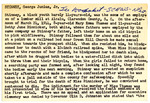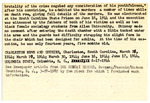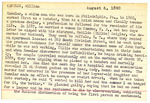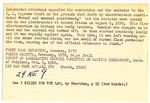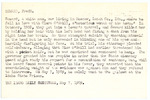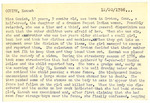Announcing the Espy Project
Telling the Stories of over 15,000 Individuals Executed in the United States since 1608
Here at the M.E. Grenander Department of Special Collections & Archives, we’re proud to announce the start of an 18-month project funded by the Council on Library and Information Resources (CLIR) Hidden Collections Program. Over the next year and a half, we will digitize the core sections of the M. Watt Espy Papers and make them available for online search and discovery, while also exposing rich metadata to promote research in digital humanities and other types of computational research.
M. Watt Espy, Jr. (1933-2009) was widely recognized as one of the foremost historians on legal executions in the United States. In May 1970, Espy began the first serious quest to chronicle and document more than 15,000 government-sanctioned executions in the United States since 1608—an effort that formally became the Capital Punishment Research Project. Espy collected information from sources scattered about the country, including state Department of Corrections records, newspapers, published and unpublished county histories, proceedings of state and local courts, magazines, and holdings of historical societies, libraries, museums, and archives.
Over the course of his research, Espy created over 28,000 typed index cards that summarize the story of each individual execution, with references to source material. The cards document brutal murders, robberies gone wrong, slave revolts, and judicial processes of states, colonies, Native American tribes, and the federal government. Some of the individuals that were executed are not documented anywhere else in the historical record, and examining the results of horribly deviant crimes provides a different perspective on society.
Espy’s research and writing profoundly shaped scholarship on capital punishment. Prior to his work, most scholars estimated there had been only 5,000 people executed in what is now the United States. Espy found evidence of over 15,000 government-sanctioned executions, and it is likely that not all executions have been documented.
Another reason that we are so excited about this project is that we will also be implementing a new digital repository for storing, managing, and maintaining thousands of new digital files. Another major part of this project is to create a central search index for all of the department’s collections. We hope that soon, unique manuscripts, university records, rare books, and digitized materials will all be located in a single search interface for easy discovery.
The impact of the project will be greatly affected by the functionality and look and feel of its web interface. To ensure success, we will incorporate user-centered design, which means we are going to get feedback from users as early as we can in the design process. This design technique will assist us in developing an interface that is intuitive and meets users' expectations.
The Espy Project will also result in tens of thousands of rich metadata records that contain individuals executed, geographic locations, full-text optical character recognition (OCR) data from the index cards, and more. All of this information will be freely exposed as linked data though an application programming interface (API) to enable a wide variety of computational use.
There are already a number of completed and concurrent projects being developed throughout academic libraries, which will allow the Espy Project to build on successes as well as adopt newly developed standards and best practices. All code produced by the project will be entered into the public domain, and we will make periodic updates to the main project page so others in the community can build on our work as much as possible.
The Espy Project Team
- Principal Investigator
- Brian Keough
- Project Managers
- Gregory Wiedeman
- Mark Wolfe
- Metadata Specialist
- Melissa McMullen
- Systems Support Team
- Adam Cybulski
- Krishna Rayavaram
- Mike Sweeney
- Graduate Student Assistants
- Miles Lawlor
- Amanda Partridge
- Sheri Sarnoff

